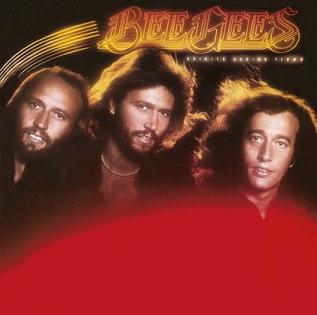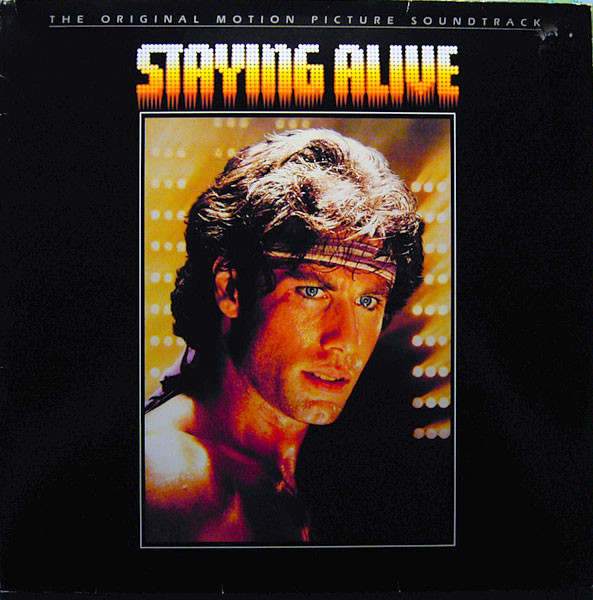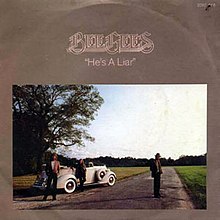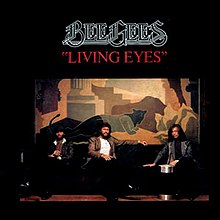
Rock and roll music
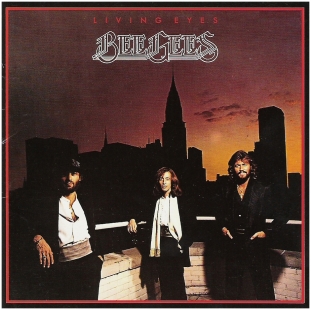
1981 studio album by the Bee Gees
Living Eyes is the sixteenth studio album (fourteenth internationally) by the Bee Gees, released in 1981. It was the band`s final album on RSO Records, which would be absorbed into Polydor and subsequently discontinued. The album showcased a soft rock sound that contrasted with their disco and R&B material of the mid-to-late 1970s; having become a prominent target of the popular backlash against disco, the Bee Gees were pressured to publicly disassociate from the genre.
Leer másLiving Eyes
The Bee Gees
Label: RSOPolydor Japan · Studios: Criteria Studios (Miami, Florida); Middle Ear Studio (Miami Beach, Florida) (string arrangements); Mediasound (New York City, New York) (horn arrangements) · Productor: Albhy Galuten , Karl Richardson
CHARTS
AUS
CAN
GER
NED
NZ
UK
US
CERTIFICATIONS
|
1
|
Living Eyes
The Bee Gees •
Bee Gees •
w: Barry, Robin and Maurice Gibb •
v: Barry •
1981 /10
|
4:20 |
|
|
|
2
|
He's A Liar
The Bee Gees •
Bee Gees •
w: Barry, Robin and Maurice Gibb •
v: Barry •
1981 /10
|
4:05 |
|
|
|
3
|
Paradise
The Bee Gees •
Bee Gees •
w: Barry, Robin and Maurice Gibb •
v: Barry and Robin •
1981 /10
|
4:21 |
|
|
|
4
|
Don't Fall In Love With Me
The Bee Gees •
Bee Gees •
w: Barry, Robin and Maurice Gibb •
v: Robin •
1981 /10
|
4:56 |
|
|
|
5
|
Soldiers
The Bee Gees •
Bee Gees •
w: Barry, Robin and Maurice Gibb •
v: Barry •
1981 /10
|
4:28 |
|
|
|
6
|
I Still Love You
The Bee Gees •
Bee Gees •
w: Barry, Robin and Maurice Gibb •
v: Robin and Maurice •
1981 /10
|
4:27 |
|
|
|
7
|
Wildflower
The Bee Gees •
Bee Gees •
w: Barry, Robin and Maurice Gibb •
v: Maurice •
1981 /10
|
4:26 |
|
|
|
8
|
Nothing Could Be Good
The Bee Gees •
Bee Gees •
w: Barry Gibb, Robin Gibb, Maurice Gibb, Albhy Galuten •
v: Barry •
1981 /10
|
4:13 |
|
|
|
9
|
Cryin' Every Day
The Bee Gees •
Bee Gees •
w: Barry, Robin and Maurice Gibb •
v: Robin and Barry •
1981 /10
|
4:05 |
|
|
|
10
|
Be Who You Are
The Bee Gees •
Bee Gees •
w: Barry Gibb •
v: Barry •
1981 /10
|
6:42 |
|
Singles
Hes a Liar
Fecha Lanzamiento: 19 September 1981 · Fecha Grabación: June 1981 -Discográfica: RSO · · Productor: Bee Gees , Albhy Galuten , Karl Richardson
CHARTS
AUS
BEL
CAN
GER
NED
UK
US
ALBUM
|
1
|
Hes a Liar
The Bee Gees •
Bee Gees •
w: Barry, Robin and Maurice Gibb •
v: Barry •
1981 /09 /19
|
4:05 |
|
|
|
2
|
Hes a Liar (Instrumental)
The Bee Gees •
Bee Gees •
w: Barry, Robin and Maurice Gibb •
v: Barry •
1981 /09 /19
|
4:05 |
|
Living Eyes
Fecha Lanzamiento: November 1981 · Fecha Grabación: June 1981 -Discográfica: RSO · · Productor: Bee Gees , Albhy Galuten , Karl Richardson
CHARTS
AUT
BEL
GER
US
ALBUM
|
1
|
Living Eyes
The Bee Gees •
Bee Gees •
w: Barry, Robin and Maurice Gibb •
v: Barry •
1981 /11
|
4:20 |
|
|
|
2
|
I Still Love You
The Bee Gees •
Bee Gees •
w: Barry, Robin and Maurice Gibb •
v: Robin and Maurice •
1981 /11
|
4:27 |
|
| Living Eyes | ||||
|---|---|---|---|---|
 | ||||
| Studio album by the Bee Gees | ||||
| Released | October 1981 | |||
| Recorded | February – June 1981 | |||
| Studio |
| |||
| Genre | Soft rock, art rock | |||
| Length | 46:04 | |||
| Label | RSO Polydor Japan | |||
| Producer | Bee Gees
| |||
| Bee Gees chronology | ||||
| ||||
| Singles from Living Eyes | ||||
| ||||
Review
1981 studio album by the Bee Gees
Living Eyes is the sixteenth studio album (fourteenth internationally) by the Bee Gees, released in 1981. It was the band`s final album on RSO Records, which would be absorbed into Polydor and subsequently discontinued. The album showcased a soft rock sound that contrasted with their disco and R&B material of the mid-to-late 1970s; having become a prominent target of the popular backlash against disco, the Bee Gees were pressured to publicly disassociate from the genre.
Leer másWhile Living Eyes did not sell well in either the UK or the US, it was a top 40 hit in the majority of territories in which it saw wide release. The album earned mixed to negative reviews from critics, and the Gibb brothers themselves have expressed their dislike of it, considering it a rush job influenced by commercial considerations.
Overview
Following the massive success from the Bee Gees production of Barbra Streisand`s album Guilty, the Bee Gees regrouped at Middle Ear studios in October 1980 to record their next album. They began work on some of the songs that would go onto Living Eyes. As they had been on all their recordings since 1975, they were backed by Blue Weaver (keyboards, synthesisers, programming), Alan Kendall (lead guitar), and Dennis Bryon (drums, percussion), but the sessions broke down and the three backing musicians were fired.[1] Alan Kendall would return to working with the Bee Gees in 1989, and he remained with them for the rest of their recording and touring career.
Recording
Recording began early in 1981 without the Bee Gees band that recorded and toured with the group in the late 1970s. Barry felt that he could create the sound he wanted with session musicians instead of a band, and the album featured musicians including Don Felder, Jeff Porcaro, Richard Tee, George Terry and Steve Gadd. Also, the Bee Gees stated that they were trying to avoid being pigeonholed as a disco act, which was why the album also featured minimal falsetto vocals (which had become a Bee Gees trademark by that time), with one notable exception being the song "Soldiers".
Barry, along with producers Albhy Galuten and Karl Richardson had developed their own production style, with Spirits Having Flown and Barbra Streisand`s #1 album Guilty. But Robin and Maurice had become active in the studio again, contributing more to vocals and production, which created some tension between them and the Gibb-Galuten-Richardson production team. Galuten later commented on why Living Eyes failed to impact both US and UK charts:
"There was a tremendous fear, that we had fallen into a rut, and I felt strongly on Living Eyes that it was time to change. When we started working on [it] and it was not being fun, I remember sitting around with my friends at the time, and saying, `It`s just not working and I think that I`m going to leave.`"[2]
Living Eyes also features the return of Robin and Maurice Gibb as a lead vocalist since 1975 in a whole song. As Barry says that his falsetto was the reason why Robin (or Maurice) had not taken lead vocals (in a whole track) on any song by the group between 1976 and 1979: "`God, every falsetto record we`re putting out is a monster, we shouldn`t change yet.` That`s what stopped us from saying, `Well it`s time Robin had a lead.` But now it`s no longer a sales point, it`s important that Robin`s voice get heard. It`s equally important that Maurice`s voice gets heard. And it`s becoming less important that I get heard. And that`s the way we work. There`s no ego within the three of us, whoever`s singing most or whoever has the most hits is irrelevant."[2]
Critical reception
"Living Eyes was a turkey, I think, for a good reason, I don`t think that last album does any harm but I`m really glad it was a turkey."[2]
– Robin Gibb, on the album`s failure unlike the group`s previous releases.
| Review scores | |
|---|---|
| Source | Rating |
| AllMusic | [3] |
| The Encyclopedia of Popular Music | [4] |
| The Great Rock Discography | 4/10[5] |
| The Philadelphia Inquirer | [6] |
| (The New) Rolling Stone Album Guide | [7] |
Sales of Living Eyes were far lower than those of their previous album, Spirits Having Flown. In the US, the disco backlash was still strong, and many radio stations outright refused to play the record because the Bee Gees name was on it. Also, RSO Records was in no position to support the group; the label`s massive investment in disco had wiped them out so thoroughly that by mid-1981, they had no functioning promotional division or marketing team. There was also an ongoing Bee Gees lawsuit against Robert Stigwood and the label, which did not help matters.
The Bee Gees themselves subsequently dismissed this album as weak, claiming that it had been recorded under pressure from their record company and management at a time when they needed to rethink their direction. Despite this, Barry commented about Living Eyes following its release, "It`s our finest album in terms of depth, performance and quality of the production. It`s been about 11 months working on this album, and we do tend to work an awful long time on our albums because we want to be sure."[2] But in 1984, Barry admitted: "Obviously, we had a scare with Living Eyes. It wasn`t the kind of album we should have brought out at that point. It was a little too downbeat, as opposed to having energy. But we were trying to go for a change, to draw ourselves away from the falsetto vocals and do something that might be a little different. We knew the risks when we did that."[2]
Barry claimed, in 1990, "Living Eyes was just what was needed for us. We needed to stop being what we were. It was driving us all round the twist. We needed at that point to step back and look at our lives as individuals."[2]
Compact Disc release
A promotional photo of the Bee Gees showing off the Living Eyes demonstration CD, with an LP copy alongside for comparison.
Living Eyes was chosen to be the first ever album to be manufactured on CD for demonstration purposes, as seen on the BBC TV program Tomorrow`s World in 1981, and was featured on the inaugural issue of the Compact Disc trade magazine.[8] It was the first Bee Gees album to be released on CD, in early 1983 when compact discs were first commercially available, though few were manufactured.
Track listing
All songs written by Barry, Robin and Maurice Gibb except where noted.
| No. | Title | Writer(s) | Lead vocals | Length |
|---|---|---|---|---|
| 1. | "Living Eyes" | Barry | 4:16 | |
| 2. | "He`s a Liar" | Barry | 4:00 | |
| 3. | "Paradise" | Barry and Robin | 4:18 | |
| 4. | "Don`t Fall in Love with Me" | Robin | 4:55 | |
| 5. | "Soldiers" | Barry | 4:25 | |
| 6. | "I Still Love You" | Robin and Maurice | 4:24 | |
| 7. | "Wildflower" | Maurice | 4:23 | |
| 8. | "Nothing Could Be Good" | Barry Gibb, Robin Gibb, Maurice Gibb, Albhy Galuten | Barry | 4:09 |
| 9. | "Cryin` Every Day" | Robin and Barry | 4:01 | |
| 10. | "Be Who You Are" | Barry Gibb | Barry | 6:38 |
Outtakes
- "Heart (Stop Beating in Time)" (later recorded by Leo Sayer and released as a single in 1982, followed by Marilyn McCoo and her single release in 1983)
- "Hold Her in Your Hand" (Barry Gibb, Maurice Gibb) (later recorded by Maurice Gibb in 1984 for the soundtrack to A Breed Apart)
- "Heat of the Night" – 4:02
- "Loving You Is Killing Me"
- "Mind over Matter" – 4:30
- "The Promise You Made" – 3:14
Personnel
Credits from Joseph Brennan.[9]
Bee Gees
- Barry Gibb – vocals, acoustic guitar (1, 3–7), guitars (1), string and horn arrangements
- Robin Gibb – vocals
- Maurice Gibb – vocals, acoustic guitar (1, 3–7), string and horn arrangements
Guest and additional musicians
- George Bitzer – acoustic piano (1, 3), synthesizers (2), Rhodes electric piano (7, 8)
- Richard Tee – Rhodes electric piano (1, 3), acoustic piano (2, 4–6, 8)
- Albhy Galuten – synthesizers (1–3, 5, 6, 9, 10), bass (9), string and horn arrangements, conductor
- Sidney Dutiel – synthesizers (9), bass (9)
- David Wolinski – Rhodes electric piano (10)
- George Terry – guitars (1, 10)
- Chuck Kirkpatrick – slide guitar (1), sitar (6), guitars (8)
- Don Felder – guitars (2–5, 7, 10)
- Harold Cowart – bass (1–5, 7, 8)
- Bob Glaub – bass (10)
- Jeff Porcaro – drums (1, 5, 9)
- Steve Gadd – drums (2–6, 8)
- Russ Kunkel – drums (7, 9, 10)
- Solly Noid – drums (9)
- Joe Galdo – snare drum (10)
- Ralph MacDonald – percussion (1, 2, 4, 5)
- Roger Troutman – percussion (5)
- Gene Orloff – contractor, conductor (10)
The Boneroo Horns on "He`s a Liar"
- Don Bonsanti
- Neil Bonsanti
- Whit Sidener
- Peter Graves (leader)
- Ken Faulk
- Brett Murphey
Brass Sextet (Tracks 4 & 10)
- Peter Graves
- Ken Faulk
- Greg Lonnman
- Brett Murphey
- Jerry Peel
- Ken Waldenpfhul
Production
- Bee Gees – producers
- Albhy Galuten – producer
- Karl Richardson – producer, engineer
- Don Gehman – engineer
- Don Brewer – assistant engineer
- Alex Clark – assistant engineer
- Lincoln Clapp – assistant engineer
- Dennis Hetzendorfer – assistant engineer
- Nick Kalliongis – assistant engineer
- Jim Pace – assistant engineer
- Dale Peterson – assistant engineer
- Al Stegmeyer – assistant engineer
- Sam Taylor – assistant engineer
- Mike Fuller – mastering
- Dick Ashby – project coordinator
- Tom Kennedy – project coordinator
- Neal Kent – project coordinator
- Glenn Ross – design
- TDK/One World Productions – design concept
- Bob Sherman – photography
- Minsei Tominaga – photography
Charts
| Chart (1981) | Position |
|---|---|
| Australian Kent Music Report[10] | 30 |
| Canadian RPM Albums Chart[11] | 32 |
| Dutch Albums Chart[12] | 7 |
| Japanese Oricon LPs Chart[13] | 26 |
| New Zealand Albums Chart[14] | 13 |
| Norwegian VG-lista Albums Chart[15] | 6 |
| Spanish Albums Chart[16] | 4 |
| Swedish Albums Chart[17] | 18 |
| UK Albums Chart[18] | 73 |
| US Billboard 200[19] | 41 |
| West German Media Control Albums Chart[20] | 37 |
Certifications and sales
| Region | Certification | Certified units/sales |
|---|---|---|
| Canada (Music Canada)[21] | Platinum | 100,000^ |
| Hong Kong (IFPI Hong Kong)[22] | Gold | 10,000* |
| Italy | — | 100,000[23] |
| Spain (PROMUSICAE)[24] | Gold | 50,000^ |
| Yugoslavia | — | 24,279[25] |
* Sales figures based on certification alone. | ||
1981 studio album by the Bee Gees
Living Eyes is the sixteenth studio album (fourteenth internationally) by the Bee Gees, released in 1981. It was the band`s final album on RSO Records, which would be absorbed into Polydor and subsequently discontinued. The album showcased a soft rock sound that contrasted with their disco and R&B material of the mid-to-late 1970s; having become a prominent target of the popular backlash against disco, the Bee Gees were pressured to publicly disassociate from the genre.
While Living Eyes did not sell well in either the UK or the US, it was a top 40 hit in the majority of territories in which it saw wide release. The album earned mixed to negative reviews from critics, and the Gibb brothers themselves have expressed their dislike of it, considering it a rush job influenced by commercial considerations.
Overview
Following the massive success from the Bee Gees production of Barbra Streisand`s album Guilty, the Bee Gees regrouped at Middle Ear studios in October 1980 to record their next album. They began work on some of the songs that would go onto Living Eyes. As they had been on all their recordings since 1975, they were backed by Blue Weaver (keyboards, synthesisers, programming), Alan Kendall (lead guitar), and Dennis Bryon (drums, percussion), but the sessions broke down and the three backing musicians were fired.[1] Alan Kendall would return to working with the Bee Gees in 1989, and he remained with them for the rest of their recording and touring career.
Recording
Recording began early in 1981 without the Bee Gees band that recorded and toured with the group in the late 1970s. Barry felt that he could create the sound he wanted with session musicians instead of a band, and the album featured musicians including Don Felder, Jeff Porcaro, Richard Tee, George Terry and Steve Gadd. Also, the Bee Gees stated that they were trying to avoid being pigeonholed as a disco act, which was why the album also featured minimal falsetto vocals (which had become a Bee Gees trademark by that time), with one notable exception being the song "Soldiers".
Barry, along with producers Albhy Galuten and Karl Richardson had developed their own production style, with Spirits Having Flown and Barbra Streisand`s #1 album Guilty. But Robin and Maurice had become active in the studio again, contributing more to vocals and production, which created some tension between them and the Gibb-Galuten-Richardson production team. Galuten later commented on why Living Eyes failed to impact both US and UK charts:
"There was a tremendous fear, that we had fallen into a rut, and I felt strongly on Living Eyes that it was time to change. When we started working on [it] and it was not being fun, I remember sitting around with my friends at the time, and saying, `It`s just not working and I think that I`m going to leave.`"[2]
Living Eyes also features the return of Robin and Maurice Gibb as a lead vocalist since 1975 in a whole song. As Barry says that his falsetto was the reason why Robin (or Maurice) had not taken lead vocals (in a whole track) on any song by the group between 1976 and 1979: "`God, every falsetto record we`re putting out is a monster, we shouldn`t change yet.` That`s what stopped us from saying, `Well it`s time Robin had a lead.` But now it`s no longer a sales point, it`s important that Robin`s voice get heard. It`s equally important that Maurice`s voice gets heard. And it`s becoming less important that I get heard. And that`s the way we work. There`s no ego within the three of us, whoever`s singing most or whoever has the most hits is irrelevant."[2]
Critical reception
"Living Eyes was a turkey, I think, for a good reason, I don`t think that last album does any harm but I`m really glad it was a turkey."[2]
– Robin Gibb, on the album`s failure unlike the group`s previous releases.
| Review scores | |
|---|---|
| Source | Rating |
| AllMusic | [3] |
| The Encyclopedia of Popular Music | [4] |
| The Great Rock Discography | 4/10[5] |
| The Philadelphia Inquirer | [6] |
| (The New) Rolling Stone Album Guide | [7] |
Sales of Living Eyes were far lower than those of their previous album, Spirits Having Flown. In the US, the disco backlash was still strong, and many radio stations outright refused to play the record because the Bee Gees name was on it. Also, RSO Records was in no position to support the group; the label`s massive investment in disco had wiped them out so thoroughly that by mid-1981, they had no functioning promotional division or marketing team. There was also an ongoing Bee Gees lawsuit against Robert Stigwood and the label, which did not help matters.
The Bee Gees themselves subsequently dismissed this album as weak, claiming that it had been recorded under pressure from their record company and management at a time when they needed to rethink their direction. Despite this, Barry commented about Living Eyes following its release, "It`s our finest album in terms of depth, performance and quality of the production. It`s been about 11 months working on this album, and we do tend to work an awful long time on our albums because we want to be sure."[2] But in 1984, Barry admitted: "Obviously, we had a scare with Living Eyes. It wasn`t the kind of album we should have brought out at that point. It was a little too downbeat, as opposed to having energy. But we were trying to go for a change, to draw ourselves away from the falsetto vocals and do something that might be a little different. We knew the risks when we did that."[2]
Barry claimed, in 1990, "Living Eyes was just what was needed for us. We needed to stop being what we were. It was driving us all round the twist. We needed at that point to step back and look at our lives as individuals."[2]
Compact Disc release
A promotional photo of the Bee Gees showing off the Living Eyes demonstration CD, with an LP copy alongside for comparison.
Living Eyes was chosen to be the first ever album to be manufactured on CD for demonstration purposes, as seen on the BBC TV program Tomorrow`s World in 1981, and was featured on the inaugural issue of the Compact Disc trade magazine.[8] It was the first Bee Gees album to be released on CD, in early 1983 when compact discs were first commercially available, though few were manufactured.
Track listing
All songs written by Barry, Robin and Maurice Gibb except where noted.
| No. | Title | Writer(s) | Lead vocals | Length |
|---|---|---|---|---|
| 1. | "Living Eyes" | Barry | 4:16 | |
| 2. | "He`s a Liar" | Barry | 4:00 | |
| 3. | "Paradise" | Barry and Robin | 4:18 | |
| 4. | "Don`t Fall in Love with Me" | Robin | 4:55 | |
| 5. | "Soldiers" | Barry | 4:25 | |
| 6. | "I Still Love You" | Robin and Maurice | 4:24 | |
| 7. | "Wildflower" | Maurice | 4:23 | |
| 8. | "Nothing Could Be Good" | Barry Gibb, Robin Gibb, Maurice Gibb, Albhy Galuten | Barry | 4:09 |
| 9. | "Cryin` Every Day" | Robin and Barry | 4:01 | |
| 10. | "Be Who You Are" | Barry Gibb | Barry | 6:38 |
Outtakes
- "Heart (Stop Beating in Time)" (later recorded by Leo Sayer and released as a single in 1982, followed by Marilyn McCoo and her single release in 1983)
- "Hold Her in Your Hand" (Barry Gibb, Maurice Gibb) (later recorded by Maurice Gibb in 1984 for the soundtrack to A Breed Apart)
- "Heat of the Night" – 4:02
- "Loving You Is Killing Me"
- "Mind over Matter" – 4:30
- "The Promise You Made" – 3:14
Personnel
Credits from Joseph Brennan.[9]
Bee Gees
- Barry Gibb – vocals, acoustic guitar (1, 3–7), guitars (1), string and horn arrangements
- Robin Gibb – vocals
- Maurice Gibb – vocals, acoustic guitar (1, 3–7), string and horn arrangements
Guest and additional musicians
- George Bitzer – acoustic piano (1, 3), synthesizers (2), Rhodes electric piano (7, 8)
- Richard Tee – Rhodes electric piano (1, 3), acoustic piano (2, 4–6, 8)
- Albhy Galuten – synthesizers (1–3, 5, 6, 9, 10), bass (9), string and horn arrangements, conductor
- Sidney Dutiel – synthesizers (9), bass (9)
- David Wolinski – Rhodes electric piano (10)
- George Terry – guitars (1, 10)
- Chuck Kirkpatrick – slide guitar (1), sitar (6), guitars (8)
- Don Felder – guitars (2–5, 7, 10)
- Harold Cowart – bass (1–5, 7, 8)
- Bob Glaub – bass (10)
- Jeff Porcaro – drums (1, 5, 9)
- Steve Gadd – drums (2–6, 8)
- Russ Kunkel – drums (7, 9, 10)
- Solly Noid – drums (9)
- Joe Galdo – snare drum (10)
- Ralph MacDonald – percussion (1, 2, 4, 5)
- Roger Troutman – percussion (5)
- Gene Orloff – contractor, conductor (10)
The Boneroo Horns on "He`s a Liar"
- Don Bonsanti
- Neil Bonsanti
- Whit Sidener
- Peter Graves (leader)
- Ken Faulk
- Brett Murphey
Brass Sextet (Tracks 4 & 10)
- Peter Graves
- Ken Faulk
- Greg Lonnman
- Brett Murphey
- Jerry Peel
- Ken Waldenpfhul
Production
- Bee Gees – producers
- Albhy Galuten – producer
- Karl Richardson – producer, engineer
- Don Gehman – engineer
- Don Brewer – assistant engineer
- Alex Clark – assistant engineer
- Lincoln Clapp – assistant engineer
- Dennis Hetzendorfer – assistant engineer
- Nick Kalliongis – assistant engineer
- Jim Pace – assistant engineer
- Dale Peterson – assistant engineer
- Al Stegmeyer – assistant engineer
- Sam Taylor – assistant engineer
- Mike Fuller – mastering
- Dick Ashby – project coordinator
- Tom Kennedy – project coordinator
- Neal Kent – project coordinator
- Glenn Ross – design
- TDK/One World Productions – design concept
- Bob Sherman – photography
- Minsei Tominaga – photography
Charts
| Chart (1981) | Position |
|---|---|
| Australian Kent Music Report[10] | 30 |
| Canadian RPM Albums Chart[11] | 32 |
| Dutch Albums Chart[12] | 7 |
| Japanese Oricon LPs Chart[13] | 26 |
| New Zealand Albums Chart[14] | 13 |
| Norwegian VG-lista Albums Chart[15] | 6 |
| Spanish Albums Chart[16] | 4 |
| Swedish Albums Chart[17] | 18 |
| UK Albums Chart[18] | 73 |
| US Billboard 200[19] | 41 |
| West German Media Control Albums Chart[20] | 37 |
Certifications and sales
| Region | Certification | Certified units/sales |
|---|---|---|
| Canada (Music Canada)[21] | Platinum | 100,000^ |
| Hong Kong (IFPI Hong Kong)[22] | Gold | 10,000* |
| Italy | — | 100,000[23] |
| Spain (PROMUSICAE)[24] | Gold | 50,000^ |
| Yugoslavia | — | 24,279[25] |
* Sales figures based on certification alone. | ||
More Albums same artist
VIDEOS
See Video Album Living EyesLiving Eyes · Channel: Bee Gees - Topic · 4m 21s


Bee Gees - He's A Liar · Channel: BeeGeesVEVO · 4m 1s

Paradise · Channel: Bee Gees - Topic · 4m 22s

Don't Fall In Love With Me · Channel: Bee Gees - Topic · 4m 58s

Soldiers · Channel: Bee Gees - Topic · 4m 29s

I Still Love You · Channel: Bee Gees - Topic · 4m 28s

Wildflower · Channel: Bee Gees - Topic · 4m 27s

Nothing Could Be Good · Channel: Bee Gees - Topic · 4m 14s

Cryin' Every Day · Channel: Bee Gees - Topic · 4m 6s




